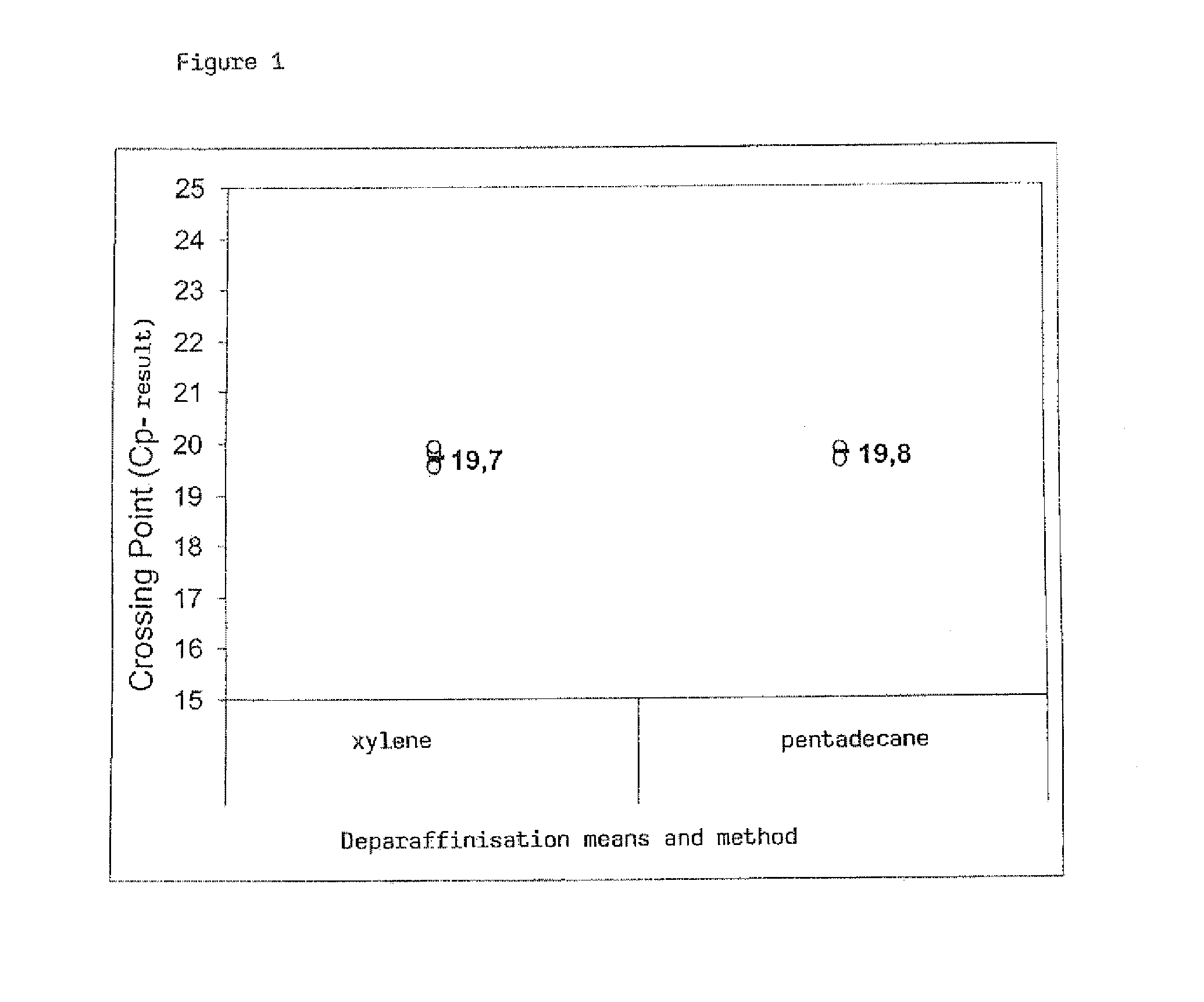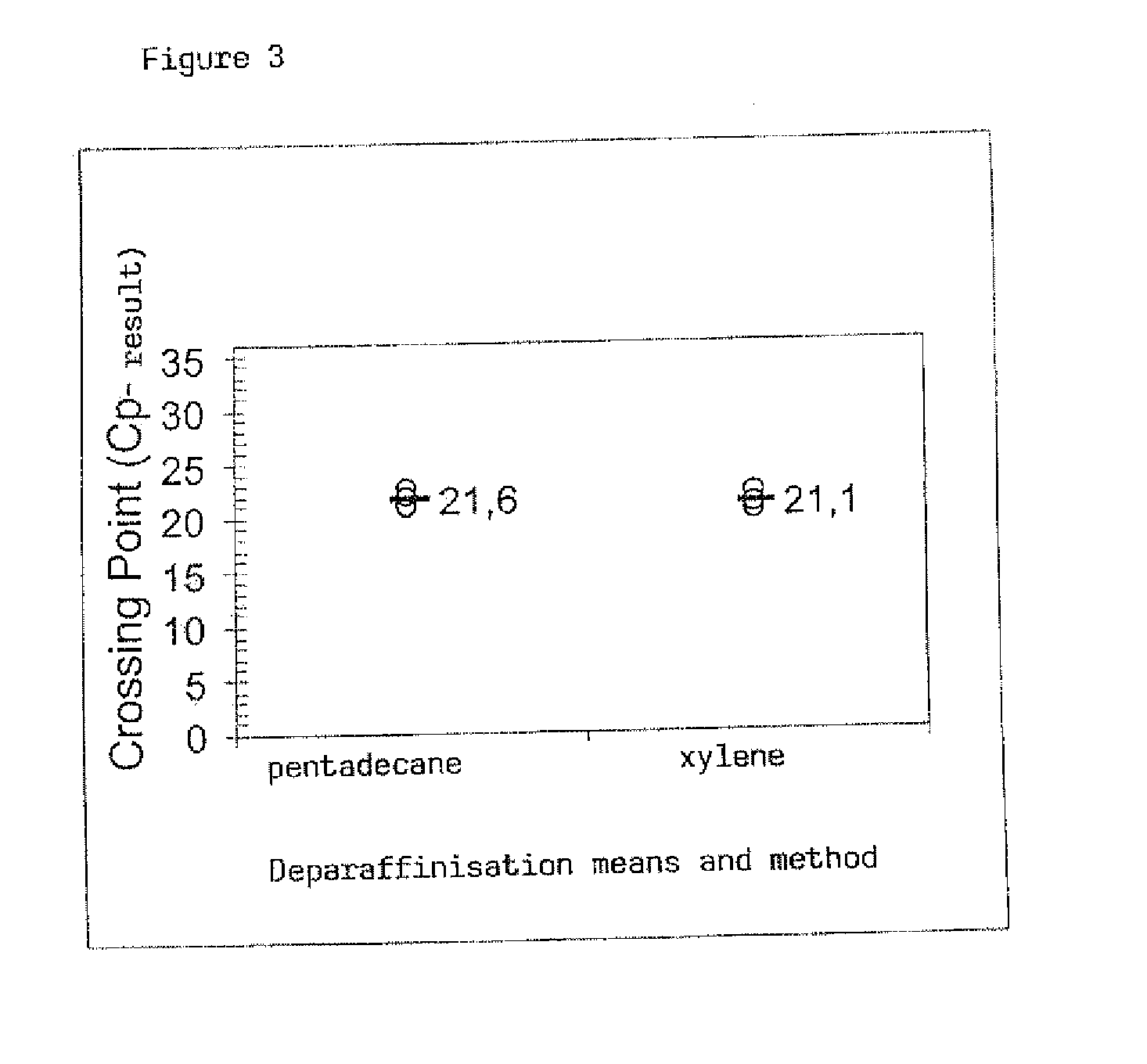Method for the deparaffinisation of biological specimens
a biological specimen and paraffinisation technology, applied in the preparation of sugar derivatives, biochemistry apparatus and processes, sugar derivatives, etc., can solve the problems of difficult to reliably automate, difficult to identify specimen material with naked eye in the solvent, complex extraction of biomolecules from this type of fixed specimen embedded in paraffin, etc., to achieve the effect of dissolving paraffin, reducing the complexity of the method, and excluding the risk of specimen material loss
- Summary
- Abstract
- Description
- Claims
- Application Information
AI Technical Summary
Benefits of technology
Problems solved by technology
Method used
Image
Examples
example 1
Isolation of RNA from Rat Liver FFPE Specimens
[0060]In order to compare the method according to the invention with the method known from the prior art using xylene in order to remove the paraffin, specimen sections with the same thickness of approximately 7.5 μm of rat liver FFPE specimens are subjected to the corresponding method protocols. As a solid phase for the isolation of nucleic acids commercially available binding columns with silica membrane are used (NucleoSpin RNAXS, MACHEREY-NAGEL, Düren). These columns can be inserted into appropriate collecting tubes and easily be processed in any commercially available centrifuge.
Protocol: Final paraffinisation with xylene (prior art)1-3 FFPE sections, 7.5 μm thick, per preparationAddition of 1 ml xyleneIncubation for 2 mins at room temperature, 25° C. (RT), vortexfor 10 secs.Centrifugation max. speed 2 mins (approx. 14,000 x g)Pippette off and discard supernatantAddition of 1 ml ethanol (~98%)Vortex for 2 secs.Centrifugation max. sp...
example 2
RNA and DNA Isolation from Rat Liver FFPE Specimens
[0071]With this experiment, in addition to RNA, DNA is also isolated from the specimens, the protocols described in Example 1 for deparaffinisation by means of a xylene method and the method according to the invention remaining unchanged. With regard to the extraction of nucleic acid, in Example 2 the DNase digestion is dispensed with, and instead of this selective elution of the genomic DNA is undertaken.
Protocol: DNA and RNA isolationDeparaffinisation with xylene and using the method accordingto the invention in Exemplary Embodiment 1.Loading of the binding column, centrifugation and discardingof the collecting tube with the throughput.Placing of the binding column with the associated RNA andDNA into a new collecting tube (2.0 ml). Unlike ExemplaryEmbodiment 1, one proceeds as follows for the elution ofthe DNA:DNAAddition of 100 μl 10 mM CaCl2, 80% ethanol, 10 mMstepsTris, pH 7.0 to the binding columnCentrifugation at 11,000 x g f...
example 3
RNA Isolation from Rat Liver FFPE Specimens by Means of Biodiesel or Sinarol as Solvents Non-Miscible with Water
[0084]The FFPE specimens are treated as described in Exemplary Embodiment 1, the deparaffinisation according to the method of the invention having been carried out with two different solvents, namely biodiesel and sinarol. Biodiesel (CAS No. 67762-38-3) is a mixture of different fatty acid methyl esters. The analysis of the isolated RNA took place by means of qRT-PCR, as described in Example 1.
[0085]In FIG. 4 the result of the comparison of these two solvents, which in relation to the yield of isolated RNA give as far as possible the same results, is shown.
PUM
| Property | Measurement | Unit |
|---|---|---|
| boiling point | aaaaa | aaaaa |
| boiling point | aaaaa | aaaaa |
| flash point | aaaaa | aaaaa |
Abstract
Description
Claims
Application Information
 Login to View More
Login to View More - R&D
- Intellectual Property
- Life Sciences
- Materials
- Tech Scout
- Unparalleled Data Quality
- Higher Quality Content
- 60% Fewer Hallucinations
Browse by: Latest US Patents, China's latest patents, Technical Efficacy Thesaurus, Application Domain, Technology Topic, Popular Technical Reports.
© 2025 PatSnap. All rights reserved.Legal|Privacy policy|Modern Slavery Act Transparency Statement|Sitemap|About US| Contact US: help@patsnap.com



